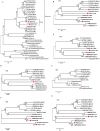Genomic characterization and high prevalence of bocaviruses in swine
- PMID: 21525999
- PMCID: PMC3078135
- DOI: 10.1371/journal.pone.0017292
Genomic characterization and high prevalence of bocaviruses in swine
Abstract
Using random PCR amplification followed by plasmid subcloning and DNA sequencing, we detected bocavirus related sequences in 9 out of 17 porcine stool samples. Using primer walking, we sequenced the nearly complete genomes of two highly divergent bocaviruses we provisionally named porcine bocavirus 1 isolate H18 (PBoV1-H18) and porcine bocavirus 2 isolate A6 (PBoV2-A6) which differed by 51.8% in their NS1 protein. Phylogenetic analysis indicated that PBoV1-H18 was very closely related to a ∼2 Kb central region of a porcine bocavirus-like virus (PBo-LikeV) from Sweden described in 2009. PBoV2-A6 was very closely related to the porcine bocavirus genomes PBoV-1 and PBoV2 from China described in 2010. Among 340 fecal samples collected from different age, asymptomatic swine in five Chinese provinces, the prevalence of PBoV1-H18 and PBoV2-A6 related viruses were 45-75% and 55-70% respectively, with 30-47% of pigs co-infected. PBoV1-A6 related strains were highly conserved, while PBoV2-H18 related strains were more diverse, grouping into two genotypes corresponding to the previously described PBoV1 and PBoV2. Together with the recently described partial bocavirus genomes labeled V6 and V7, a total of three major porcine bocavirus clades have therefore been described to date. Further studies will be required to elucidate the possible pathogenic impact of these diverse bocaviruses either alone or in combination with other porcine viruses.
Conflict of interest statement
Figures



References
-
- Claude M, Fauquet MAM, Maniloff J, Desselberger U, Ball LA, editors. Virus Taxonomy: The Eighth Report of the International Committee on Taxonomy of Viruses. Academic Press; 2004.
-
- Manteufel J, Truyen U. Animal bocaviruses: a brief review. Intervirology. 2008;51:328–334. - PubMed
Publication types
MeSH terms
Associated data
- Actions
- Actions
- Actions
- Actions
- Actions
- Actions
- Actions
- Actions
- Actions
- Actions
- Actions
- Actions
- Actions
- Actions
- Actions
- Actions
- Actions
- Actions
- Actions
- Actions
- Actions
- Actions
- Actions
- Actions
- Actions
- Actions
- Actions
- Actions
- Actions
- Actions
- Actions
- Actions
- Actions
- Actions
- Actions
- Actions
LinkOut - more resources
Full Text Sources
Other Literature Sources

